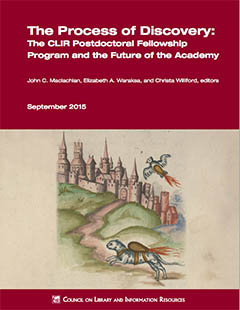By Elizabeth Waraksa

In contemplating cover images for the recently published report marking the first decade of the CLIR Postdoctoral Fellowship Program, The Process of Discovery: The CLIR Postdoctoral Fellowship Program and the Future of the Academy, we (the co-editors) considered a variety of options for visualizing both the content of the volume and the experiences of those involved with the program. As we pored over stock photos, vector graphics, and manuscript illustrations, we asked ourselves: Could an abstract image of a molecule convey the collaborative effort that undergirds the program, as well as the collaborative writing group that produced the bulk of the report? Does an illustration of a smart classroom accurately evoke the pedagogy of the program, as well as the talents of the fellows and the technologies with which they work at their host institutions? Would it be anachronistic to feature a tablet computer on the front of a report that covers the years 2004-2015? The image we eventually settled on—the “rocket cat” illustration from an early modern manuscript at the University of Pennsylvania library—was a suggestion first made partly in jest. However, we concluded that the image was much more than a quirky (if rather grim) illustration for a proposed use of animals as incendiary devices in 16th century European warfare. The sentiments that the “rocket cat” illustration evoke for us are, like the process of discovery itself, far more complex.
As both a physical and digital object that has received quite a bit of media attention of late (thanks in part to a thorough and thoroughly engaging blog post by former CLIR postdoctoral fellow Mitch Fraas), the image of a cat and bird outfitted with flaming explosive devices hurtling toward a collection of stone buildings on a hill is, to us, more than just a tongue-in-cheek reference to CLIR postdoctoral fellows as “feral librarians” or infiltrators in the world of academic libraries. Rather, we feel it accurately captures the sense of purpose—and awe—that fellows feel as they anticipate their fellowships at their host institutions: the fear, but also excitement, of launching into a new, challenging endeavor. Bursting with energy, and equipped with ideas and skills newly acquired in graduate school, fellows are often eager to “set fire” to their new institutions through their creative approaches to the uncertainty facing research libraries and higher education today. And while the journey ahead may initially feel precarious, it is nevertheless one that stands firmly in the tradition of the transfer of knowledge and skills from expert to expert, the history of scientific experimentation, and the application of new technologies to vexing problems.
CLIR postdoctoral fellowship hosts, in welcoming fellows for a period of one to two years to work on bounded projects of pressing need, may likewise feel such fear and awe, but they, too, recognize that they are hurtling toward the future at high speed, and thus, in their fellows, seek new modes of collaboration, new ways to invigorate their collections and services, and a suite of talents that can bring new insight to traditional modes of knowledge transfer. The hosts’ and fellows’ journeys may be uncertain, or even potentially uncomfortable, at the outset, but as the decade-plus of the program has demonstrated, they are nevertheless endeavors worth pursuing with eyes wide open, full steam ahead.
Finally, as Christa Williford notes in the Afterword to the volume, CLIR itself has been engaged in a process of discovery alongside its postdoctoral fellows and their host institutions. The program was, at the outset, an experiment, albeit one with high hopes for success. It has become, over time, a flagship program of CLIR, and one that is continually changing, expanding and reflecting on is mission and goals. As a community, the CLIR Postdoctoral Fellowship Program finds strength in its accomplishments and opportunities in its challenges, rocketing forward as it not only contemplates, but proposes, tests, and promotes an empathetic, optimistic future for the academy.
Elizabeth Waraksa is an independent consultant with several years’ experience working with the CLIR Postdoctoral Fellowship Program. She is a co-editor, together with John Maclachlan (McMaster University) and Christa Williford (CLIR), of CLIR’s recent publication, The Process of Discovery: The CLIR Postdoctoral Fellowship Program and the Future of the Academy.

